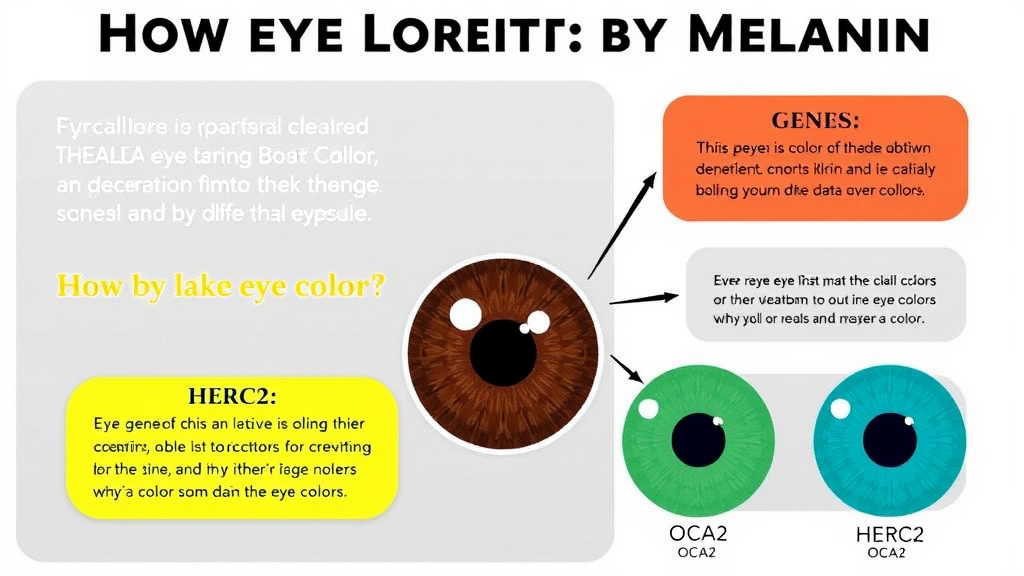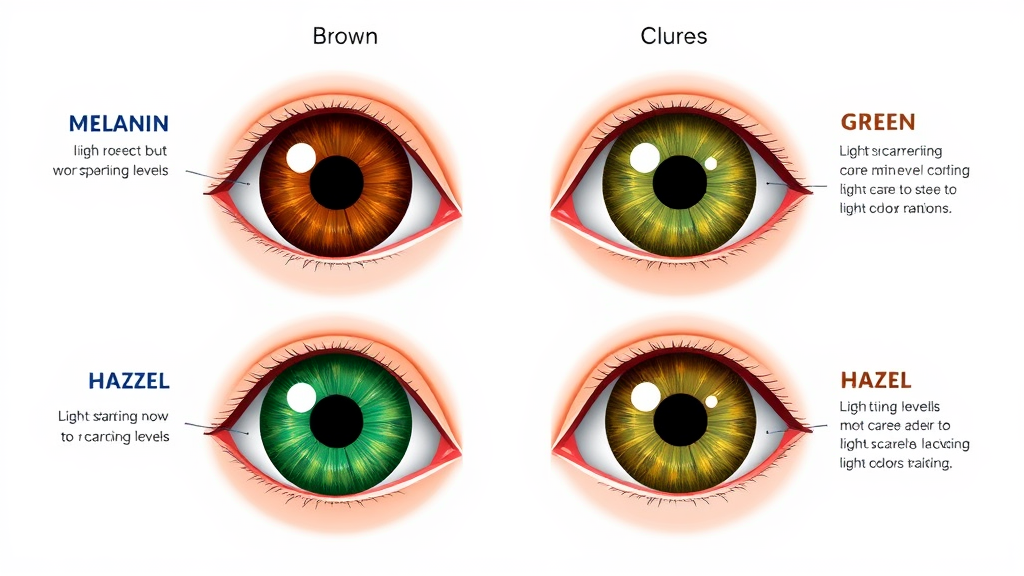Eye color is a fascinating trait influenced by genetics, melanin levels, and light scattering within the iris. While brown, blue, and hazel eyes are common, certain eye colors are exceptionally rare and often surrounded by intrigue. This blog explores these uncommon eye colors, delving into their causes and the science behind their occurrence.
Key Findings
-
Green eyes are among the rarest, present in approximately 2% of the global population. (aarp.org)
-
Gray eyes are also rare, with less than 1% of people worldwide possessing this eye color. (verywellhealth.com)
-
Amber eyes are uncommon, found in about 5% of the global population. (icoice.com)
-
Red or violet eyes can occur in individuals with albinism due to the lack of melanin, allowing blood vessels to show through the iris. (health.howstuffworks.com)
-
Heterochromia is a condition where an individual has two different colored eyes or variations within the same iris, resulting from genetic factors or medical conditions. (en.wikipedia.org)
What Are the Rarest Eye Colors and Their Global Distribution?
Eye color is determined by the amount and distribution of melanin in the iris, with variations resulting from genetic factors and light scattering. While brown is the most prevalent eye color globally, certain hues are exceptionally rare.
Rarest Eye Colors and Their Global Distribution:
-
Gray Eyes: Gray eyes are among the rarest, accounting for less than 1% of the global population. This coloration results from a unique combination of low melanin levels and the presence of collagen in the iris, affecting light reflection and scattering. Gray eyes are more commonly found in individuals of Northern and Eastern European descent.
-
Green Eyes: Approximately 2% of the world's population has green eyes, making them one of the rarest eye colors. This hue arises from a combination of low melanin levels and the Rayleigh scattering of light. Green eyes are most prevalent in Northern and Central Europe, particularly in countries like Iceland and Ireland.
-
Amber Eyes: Amber eyes, characterized by a solid golden or coppery hue, are found in about 5% of the global population. This coloration is due to the presence of the pigment lipochrome and low levels of melanin. Amber eyes are more commonly observed in regions of Asia and South America.
-
Hazel Eyes: Hazel eyes, exhibiting a mix of brown, green, and gold, are present in approximately 10% of the world's population. This eye color results from a combination of melanin distribution and light scattering. Hazel eyes are more common in individuals of Spanish heritage and those from the Middle East.
-
Red/Violet Eyes: Extremely rare, red or violet eyes occur in less than 0.01% of the population. This unique coloration is typically associated with albinism, where a lack of melanin allows blood vessels to show through the iris, giving a reddish or violet appearance.
Understanding the rarity and distribution of these eye colors highlights the complex interplay of genetics and environmental factors in human diversity.
External Sources: Learn More
The Genetic Basis Behind Uncommon Eye Colors
Eye color is primarily determined by the type and amount of melanin pigment present in the iris, with variations resulting from complex genetic interactions. While brown eyes are the most common globally, uncommon eye colors such as green, gray, and amber arise from specific genetic variations affecting melanin production and distribution.
Key Genes Influencing Eye Color
Several genes play pivotal roles in determining eye color by regulating melanin synthesis and distribution:
-
OCA2 (Oculocutaneous Albinism II): Located on chromosome 15, this gene influences melanin production in the iris. Variants in OCA2 can lead to a range of colors from dark brown to light blue by regulating melanin deposition. Mutations in OCA2 can also contribute to albinism, where melanin production is significantly reduced.
-
HERC2: Also situated on chromosome 15, HERC2 contains a regulatory element that controls the expression of OCA2. A specific mutation in HERC2 reduces OCA2 activity, resulting in lower melanin levels and the development of blue eyes.
-
TYR (Tyrosinase): This gene encodes an enzyme essential for the initial steps of melanin production. Mutations in TYR can lead to albinism, significantly reducing pigmentation in the iris and resulting in very light or even red eyes.
-
SLC24A4 and SLC45A2: These genes are involved in pigment transport and development. Variants are associated with lighter eye colors, such as blue and green.
-
IRF4 (Interferon Regulatory Factor 4): This gene regulates melanin production and is linked to lighter eye colors. It also influences traits like hair graying and freckling.
-
TYRP1 (Tyrosinase-Related Protein 1): TYRP1 affects the type of melanin produced, influencing the spectrum from dark brown to amber hues.
-
ASIP (Agouti Signaling Protein): ASIP regulates melanin pathways, indirectly influencing eye pigmentation.
Genetic Complexity and Rare Eye Colors
The inheritance of eye color is polygenic, involving multiple genes that interact to produce a continuum of colors. Recent genome-wide association studies have identified numerous genetic loci associated with eye color, highlighting its complex genetic architecture.
Rare eye colors such as green, gray, and amber result from specific combinations of genetic variations affecting melanin production and distribution. For instance, green eyes are associated with a combination of low to moderate melanin levels and specific genetic variants.
Understanding the genetic basis behind uncommon eye colors provides insight into human genetic diversity and the intricate mechanisms governing pigmentation.
External Sources: Learn More
How Melanin Levels Influence Eye Color Variations
Eye color is primarily determined by the type and amount of melanin pigment present in the iris. Melanin exists in two forms: eumelanin, which imparts brown to black hues, and pheomelanin, responsible for red to yellow tones. The specific combination and concentration of these pigments influence the wide spectrum of human eye colors.
Individuals with brown eyes possess a high concentration of eumelanin in the iris, resulting in the absorption of most light and the reflection of brown hues. In contrast, blue eyes have minimal melanin, and their color arises from the scattering of light within the iris, a phenomenon similar to Rayleigh scattering that makes the sky appear blue. Green eyes result from a moderate amount of melanin combined with the presence of pheomelanin, leading to the reflection of green wavelengths. Hazel eyes exhibit a mix of brown and green tones due to varying melanin concentrations across the iris.
The production and distribution of melanin in the iris are regulated by multiple genes, with OCA2 and HERC2 playing significant roles. Variations in these genes can influence melanin levels, thereby affecting eye color. For instance, certain polymorphisms in the OCA2 gene can reduce melanin production, leading to lighter eye colors such as blue or green.
Understanding the relationship between melanin levels and eye color variations provides insight into the complex genetic and biochemical processes that contribute to human diversity.
External Sources: Learn More
The Role of Light Scattering in Unique Eye Color Perception
Eye color is primarily determined by the pigmentation of the iris and the scattering of light within its structure. While melanin concentration dictates darker hues, the perception of unique eye colors such as blue, green, and gray arises from light scattering phenomena within the iris's stroma.
In individuals with low melanin levels in the iris, shorter wavelengths of light (blue and violet) are scattered more than longer wavelengths, resulting in the blue appearance of the eyes. This effect, known as Rayleigh scattering, is similar to the phenomenon that makes the sky appear blue.
Green eyes result from a combination of light brown or amber pigmentation in the stroma and the Rayleigh scattering of light. The presence of the yellowish pigment lipochrome, along with the scattering effect, gives the eyes their green appearance.
Gray eyes may have larger deposits of collagen in the stroma, causing light to undergo Mie scattering, which is not strongly frequency-dependent. This results in a gray appearance, analogous to the color of the sky on a cloudy day.
Understanding these light scattering mechanisms provides insight into the diverse range of human eye colors beyond the influence of melanin alone.
External Sources: Learn More
Medical Conditions That Can Alter Eye Pigmentation
Several medical conditions can lead to alterations in eye pigmentation, affecting the color of the iris, sclera, or other ocular structures. These changes may result from genetic mutations, metabolic disorders, or the side effects of certain medications.
Ocular Albinism
Ocular albinism is a genetic condition that primarily affects the eyes, reducing pigmentation in the iris and retina. This lack of pigmentation can lead to visual impairments such as reduced visual acuity, nystagmus (involuntary eye movements), and photophobia (sensitivity to light). Unlike other forms of albinism, ocular albinism does not significantly affect skin and hair color.
Waardenburg Syndrome
Waardenburg syndrome is a group of genetic conditions characterized by varying degrees of hearing loss and pigmentation anomalies. Individuals with this syndrome may exhibit heterochromia iridum (two different colored eyes or multiple colors within one eye), brilliant blue eyes, or patches of depigmented skin and hair. These pigmentation changes result from mutations affecting melanocyte development.
Alkaptonuria
Alkaptonuria is a rare metabolic disorder caused by a deficiency of the enzyme homogentisic acid oxidase, leading to the accumulation of homogentisic acid in connective tissues. This accumulation can cause a bluish-black discoloration of the sclera, known as ochronosis. Ocular manifestations typically appear by the fourth decade of life and may be accompanied by other systemic complications.
Minocycline-Induced Pigmentation
Long-term use of the antibiotic minocycline can lead to pigmentation changes in various tissues, including the eyes. Patients may develop a bluish-gray discoloration of the sclera, often presenting as bands near the limbus (the border between the cornea and sclera). This pigmentation may resolve over time after discontinuation of the drug but can be permanent in some cases.
Endocrine Disorders
Certain endocrine disorders, such as Addison's disease, can cause increased pigmentation of the skin and mucous membranes, including the conjunctiva. This may result in a darkening of the sclera, giving the eyes a brownish appearance. These changes are due to elevated levels of adrenocorticotropic hormone (ACTH), which stimulates melanin production.
Understanding these conditions is crucial for the early detection and management of associated ocular and systemic complications.
External Sources: Learn More
Cultural and Historical Perspectives on Rare Eye Colors
Rare eye colors have held significant cultural and historical meanings across various societies, often symbolizing unique traits or supernatural abilities.
In ancient Egypt, blue eyes were revered as a blessing from the gods, symbolizing divine favor. Similarly, amber eyes were associated with the sun god Ra, representing power and vitality. (ancientspast.com, zennioptical.com)
During the Medieval period in Europe, green eyes were often linked to witchcraft and sorcery, leading to suspicion and fear towards individuals possessing them.
In Native American folklore, heterochromia—having two different colored eyes—was sometimes believed to grant the ability to see both heaven and Earth simultaneously.
In Africa, where melanin-rich skin tones dominate, green eyes are particularly rare and often spark curiosity and fascination. They are viewed as a unique and striking feature, sometimes associated with exotic beauty and a connection to the outside world.
These cultural interpretations highlight the diverse ways rare eye colors have been perceived throughout history, reflecting societal values, beliefs, and the human tendency to attribute deeper meanings to physical traits.
External Sources: Learn More
FAQ – Frequently Asked Questions
What is the rarest eye color in the world?
Gray eyes are among the rarest natural eye colors, found in less than 1% of the global population. This rarity is due to minimal melanin in the iris and unique light scattering, resulting in the gray appearance.
Can two brown-eyed parents have a child with a rare eye color?
Yes, two brown-eyed parents can have a child with a rare eye color, such as blue or green. Eye color is determined by multiple genes, and parents can carry recessive alleles for lighter eye colors without expressing them. If both parents pass these recessive alleles to their child, the child may inherit a rare eye color. While uncommon, this genetic combination is possible.
Are certain rare eye colors more prevalent in specific regions?
Yes, certain rare eye colors are more prevalent in specific regions:
-
Green Eyes: Approximately 2% of the global population has green eyes. They are most common in Northern and Central Europe, with notable concentrations in countries like Iceland, where about 16% of people have green eyes, and Spain, where approximately 20% of the population has them.
-
Gray Eyes: Gray eyes are the second-rarest natural eye color, found in about 3% of the world's population. They are more common in parts of Central Asia, South Asia, the Middle East, and among the Algerian Shawia people in Northwest Africa.
-
Amber Eyes: Amber eyes are rare globally but appear at higher frequencies in regions such as Southern Europe (Spain, Italy, Greece), West Asia (Turkey, Armenia, Iran), South Asia (India, Afghanistan), North Africa (Morocco, Egypt, Somalia), and Central and South America. Within these areas, amber eyes appear in 1-5% of the native population.
-
Blue Eyes: Approximately 8-10% of the global population has blue eyes. They are predominantly found in Northern and Eastern Europe, particularly around the Baltic Sea. For instance, in Finland and Sweden, the prevalence of blue eyes can be as high as 80-90%.
These variations are largely due to genetic factors and historical population movements.
How does albinism affect eye color?
Albinism affects eye color by reducing melanin production in the iris, leading to lighter eye colors such as light blue, gray, or light brown. In severe cases, the lack of pigment allows underlying blood vessels to show through, causing the eyes to appear pink or red under certain lighting conditions. This reduced pigmentation can also result in increased light sensitivity and vision problems.
Is it possible for eye color to change over time?
Yes, eye color can change over time due to various factors:
-
Infancy and Early Childhood: Many babies are born with blue or gray eyes that may darken as melanin production increases during the first few years of life.
-
Adolescence and Adulthood: Approximately 10–15% of Caucasians experience eye color changes during adolescence and adulthood, often due to genetic factors.
-
Aging: Some individuals notice their eye color lightening with age, possibly due to decreased melanin production.
-
Sun Exposure: Prolonged exposure to sunlight can increase melanin in the iris, leading to a slight darkening of eye color.
-
Hormonal Changes: Fluctuations during puberty, pregnancy, or menopause can influence melanin production, causing minor eye color variations.
-
Medical Conditions: Certain diseases, medications, or injuries can lead to changes in eye color.
If you notice a significant or sudden change in your eye color, it's advisable to consult an eye care professional to rule out underlying health issues.



